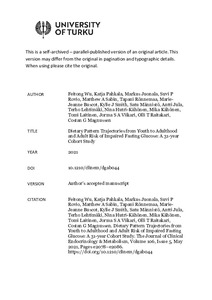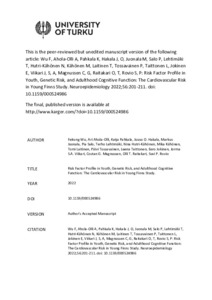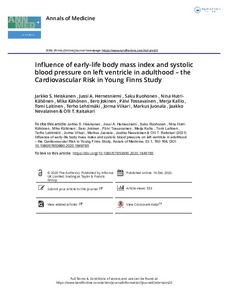Hae
Aineistot 1-5 / 5
Childhood and long-term dietary calcium intake and adult cardiovascular risk in a population with high calcium intake
<p>Background & aims</p><p>The influence of dietary calcium intake in childhood on adult cardiovascular health is unknown, particularly in those with long-term high intake. To examine both linear and non-linear associations ...
Dietary Pattern Trajectories from Youth to Adulthood and Adult Risk of Impaired Fasting Glucose: A 31-year Cohort Study
<p><b>Context</b></p><p>The influence of dietary pattern trajectories from youth to adulthood on adult glucose metabolism is unknown.<br></p><p><b>Objective</b></p><p>To identify dietary pattern trajectories from youth to ...
Childhood and Adulthood Passive Smoking and Nonalcoholic Fatty Liver in Midlife: A 31-year Cohort Study
INTRODUCTION: Identifying early life risk factors remains key to the prevention of nonalcoholic fatty liver (hereinafter "fatty liver") in adulthood. However, the longitudinal association of childhood passive smoking with ...
Risk Factor Profile in Youth, Genetic Risk, and Adulthood Cognitive Function: The Cardiovascular Risk in Young Finns Study
<p>INTRODUCTION</p><p>The role of risk factor profile in childhood and adolescence on adulthood cognitive function and whether it differs by genetic risk is still obscure. To bring this evidence, we determined cognitive ...
Influence of early-life body mass index and systolic blood pressure on left ventricle in adulthood - the Cardiovascular Risk in Young Finns Study
<p>Background<br></p><p>Increased left ventricular mass (LVM) predicts cardiovascular events and mortality. The objective of this study was to determine whether early-life exposures to body mass index (BMI) and systolic blood pressure (SPB) affects the left ventricular structure in adulthood.<br></p><p>Methods<br></p><p>We used longitudinal data from a 31-year follow-up to examine the associations between early-life (between ages 6-18) BMI and SPB on LVM in an adult population (N = 1864, aged 34-49). The burden of early-life BMI and SBP was defined as area under the curve.<br></p><p>Results<br></p><p>After accounting for contemporary adult determinants of LVM, early-life BMI burden associated significantly with LVM (3.61 g/SD increase in early-life BMI; [1.94 - 5.28], p < 0.001). Overweight in early-life (age- and sex-specific BMI values corresponding to adult BMI > 25 kg/m<sup>2</sup>) associated with 4.7% (2.5-6.9%, p < 0.0001) higher LVM regardless of BMI status in adulthood. Overweight in early-life combined with obesity in adulthood (BMI > 30kg/m<sup>2</sup>) resulted in a 21% (17.3-32.9%, p < 0.0001) increase in LVM. Higher early-life BMI was associated with a risk of developing eccentric hypertrophy. The burden of early-life SPB was not associated with adult LVM or left ventricular remodeling.<br></p><p>Conclusions<br></p><p>High BMI in early-life confers a sustained effect on LVM and the risk for eccentric hypertrophy independently of adulthood risk factors.</p>...




